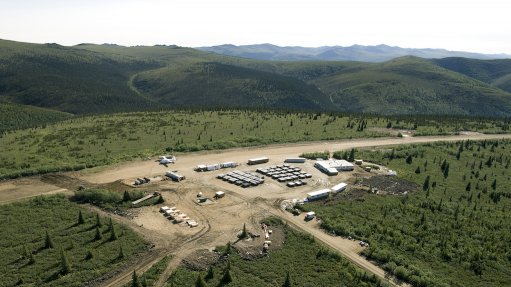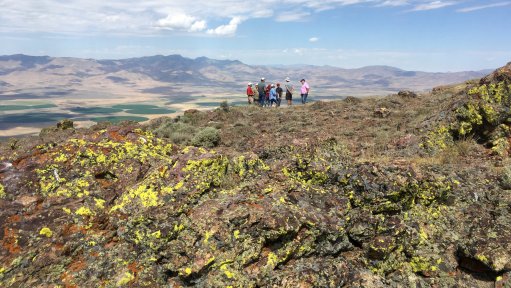Rising uptake of vanadium-based batteries bodes well for market as price turns a corner
VANCOUVER (miningweekly.com) – A more than 40% increase in the price of vanadium pentoxide (V2O5) since December lows is invigorating the industry, just as it is poised to see significant new demand for the steel-strengthening ingredient coming from the increasing adoption rate of vanadium-redox flow batteries (VRBs).
The commodity started 2015 with a mid price of $5.03/lb of V2O5, but it had all but halved as at December 31, falling to $2.38/lb. However, prices showed signs of recovery in the first quarter, with a price of between $2.70/lb and $3/lb at March 31, and a current mid price of $3.35/lb, according to Metal Bulletin.
Australian Vanadium (AVL) MD Vincent Algar believes that the vanadium price truly bottomed this year, boosted by the closure of the world’s highest-grade vanadium producer South Africa’s Evraz Highveld Steel & Vanadium (Highveld).
“The vanadium market is in turmoil ever since Highveld went into insolvency due to lower steel demand from China, which sent prices spiralling to unsustainable levels,” he told Mining Weekly Online in an interview.
This had led to substantially more interest in the company’s flagship Western Australia-based Gabanintha project from investors, especially those in China and South Korea.
However, steel demand continues and, despite new vanadium production coming on stream in the form of Largo Resources ramping up its Maracás Menchen mine, in Brazil, supply is not enough to fill the gap left by Highveld.
EXPANDING DEMAND
Algar noted that a critical part of ASX-listed AVL’s strategy to become a fully integrated vertical in this emerging market is to get its high-grade Gabanintha project to the production phase to service the expanding supply gap.
According to Algar, battery storage is expected to grow to 185 GWh in the next few years, with VRBs expected to make up about 30% of that demand. That would result in at least 300 000 t of extra vanadium demand in an already tight market.
“The use of vanadium in energy storage solutions is growing at unprecedented levels. While lithium-ion batteries will continue to be dominant, owing to their high density, VRBs will increasingly take a slice of the pie when it comes to larger stationary energy storage solutions,” he advised.
Algar pointed to significant technological advancements made over recent years by pioneers of VRB technology, such as Japan’s Sumitomo Corp, which led to the development of containerised products that provide opportunities to compete with traditional lithium-ion battery applications.
The increasing adoption rate of VRBs around the globe is sparking a wave of new demand for vanadium. Where vanadium makes up about 0.2% of modern strengthened steel products, a litre of vanadium electrolyte in a VRB needs about 145 g of vanadium oxide.
“Based on an extremely conservative scenario, VRB-based vanadium demand will double the current market in about five years. And this has got some major new players paying attention too,” he stated.
Algar has been appointed chairperson of industry association Vanitec’s newly created energy storage committee to promote the use of vanadium bearing materials. The energy storage committee reports to the Vanitec market development committee and will oversee developments in the energy industry market for vanadium. Its focus is to identify future global vanadium demand, the quality required and operational health and safety guidelines surrounding electrolyte production and distribution.
Meanwhile, steel, which consumes about 92% of vanadium produced, continues to be the commodity’s price driver, and demand for use in rebar continues to increase at 6% a year, while new markets in steel will increase demand in sectors and products such as automotive, aviation and aerospace; power lines and power pylons; and high-strength steel structures.
ESTABLISHED TECHNOLOGY
Algar stressed that VRBs are today a well established technology at commercial deployment status.
“VRBs provide a way to store and resupply renewable energy. Their very high capacity is ideal for large-scale energy storage applications, unlocking the full potential of renewables while maintaining grid security,” he said.
Among the advantages of VRBs are ease of scalability; a life span of at least 20 years with a very high cycle life and no capacity loss over time; only one electrolyte – V2O5, which can be recycled; immediate and rapid energy release; excellent charge retention (up to a year); 100% discharge with no damage; improved safety; and a low replacement rate compared with lithium-ion batteries.
According to Algar, the VRB market beckons in Australia, given rising electricity costs and the country having some of the world’s most extended power networks, providing many fringe-of-grid and off-grid opportunities.
The Australian storage market alone is expected to grow to 3 000 MWh by 2030.
For this reason, AVL has entered several agreements with downstream players which, if successful, would help stimulate the local vanadium market, said Algar.
The company has a partnership with German VRB developer and manufacturer Gildemeister Energy Solutions to market and sell VRBs – with the first Gildemeister CellCube FB 10-100 to be installed at a Busselton agricultural property as part of a 15 kW solar photovoltaic (PV) installation in the next two weeks.
The CellCube can deliver up to 10 kW of power and has a storage capacity of 100 kWh. This can provide up to ten hours of renewable power to the site, supplied by charging from the solar PV system.
The CellCube will provide three-phase power to the site, which currently has only a single-phase power connection to the grid. The installation is expected to render the client 90% self-sufficient for power needs.
AVL has also entered into a partnership agreement with Australia-wide commercial solar solution company Sun Connect for the installation of integrated solar and VRB solutions.
With a memorandum of understanding in place, AVL and Sun Connect were actively evaluating several potential integrated solar and VRB installations throughout Australia.
Further, C-Tech Innovation, a UK research and technology company supplying technology for electrochemical application, has partnered with AVL to collaborate on VRB opportunities at installations throughout Australia.
In particular, AVL and C-Tech will collaborate on building a vanadium electrolyte plant in Australia, and C-Tech will assist in integrating electrolyte production capacity into the Gabanintha project design.
ROBUST PROJECT
Critically, Algar noted that rising vanadium prices were making immediate improvements to the Gabanintha project economics, owing to its higher resource grades, which Algar rates third in line after Highveld’s South African operations and Largo’s Maracas Menchen mine.
Gabanintha has a Joint Ore Reserves Committee-compliant total resource of 91.4-million tonnes at 0.82% V2O5, 10% titanium dioxide (TiO2) and 35% iron (Fe), with a separate high-grade measured indicated and inferred resource of 56.8-million tonnes grading 1% V2O5, 11% TiO2 and 42% Fe.
Importantly, the deposit is at surface and suitable for openpit mining and open at depth.
Algar stated that the next key deliverable for the company would be to complete a preliminary feasibility study on the project.
He believes the company’s ASX-listed stock has been significantly undervalued, despite shares doubling in value so far this year to A$0.02 apiece.
Comments
Press Office
Announcements
What's On
Subscribe to improve your user experience...
Option 1 (equivalent of R125 a month):
Receive a weekly copy of Creamer Media's Engineering News & Mining Weekly magazine
(print copy for those in South Africa and e-magazine for those outside of South Africa)
Receive daily email newsletters
Access to full search results
Access archive of magazine back copies
Access to Projects in Progress
Access to ONE Research Report of your choice in PDF format
Option 2 (equivalent of R375 a month):
All benefits from Option 1
PLUS
Access to Creamer Media's Research Channel Africa for ALL Research Reports, in PDF format, on various industrial and mining sectors
including Electricity; Water; Energy Transition; Hydrogen; Roads, Rail and Ports; Coal; Gold; Platinum; Battery Metals; etc.
Already a subscriber?
Forgotten your password?
Receive weekly copy of Creamer Media's Engineering News & Mining Weekly magazine (print copy for those in South Africa and e-magazine for those outside of South Africa)
➕
Recieve daily email newsletters
➕
Access to full search results
➕
Access archive of magazine back copies
➕
Access to Projects in Progress
➕
Access to ONE Research Report of your choice in PDF format
RESEARCH CHANNEL AFRICA
R4500 (equivalent of R375 a month)
SUBSCRIBEAll benefits from Option 1
➕
Access to Creamer Media's Research Channel Africa for ALL Research Reports on various industrial and mining sectors, in PDF format, including on:
Electricity
➕
Water
➕
Energy Transition
➕
Hydrogen
➕
Roads, Rail and Ports
➕
Coal
➕
Gold
➕
Platinum
➕
Battery Metals
➕
etc.
Receive all benefits from Option 1 or Option 2 delivered to numerous people at your company
➕
Multiple User names and Passwords for simultaneous log-ins
➕
Intranet integration access to all in your organisation


















